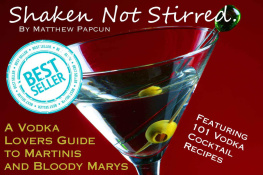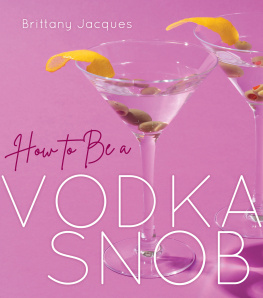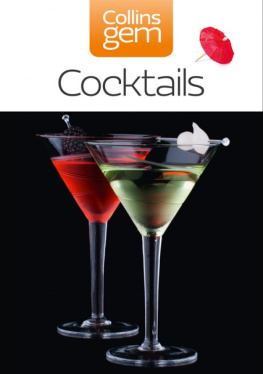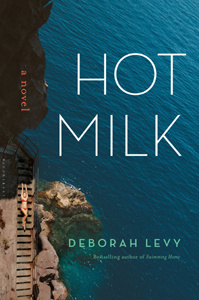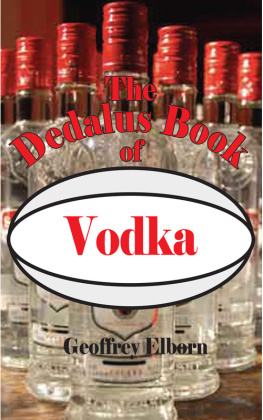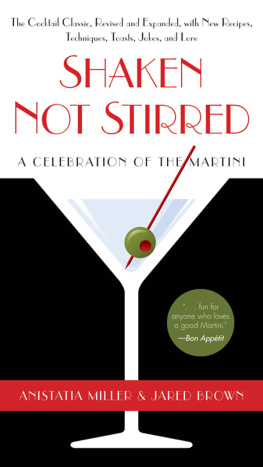Shaken, Not Stirred. A Vodka Lovers Guide to Martinis & Bloody Marys Featuring 101 of The Best Vodka Cocktail Recipes Matthew Papcun 2012 All Rights Reserved. No part of this publication may be reproduced in any form or by any means, including scanning, photocopying, or otherwise without prior written permission of the copyright holder. Disclaimer and Terms of Use: The Author and Publisher has strived to be as accurate and complete as possible in the creation of this book, notwithstanding the fact that he does not warrant or represent at any time that the contents within are accurate due to the rapidly changing nature of the Internet. While all attempts have been made to verify information provided in this publication, the Author and Publisher assumes no responsibility for errors, omissions, or contrary interpretation of the subject matter herein. Any perceived slights of specific persons, peoples, or organizations are unintentional.
In practical advice books, like anything else in life, there are no guarantees of income made. This book is not intended for use as a source of legal, business, accounting or financial advice. All readers are advised to seek services of competent professionals in legal, business, accounting, and finance field. First Printing, 2012 Printed in the United States of America Dedication To all of those with whom Ive shared a drink along the way and my loving and supportive family and girlfriend, salute .
Table of Contents
Introduction
Vodka is one of the oldest distilled spirits in existence and remains one of the top-selling in the world. Everyone has drank vodka in some shape or form at some point in their life; whether it was in a Cosmopolitan, Apple Martini or one hazy night with a bottle of Popov.
Maybe you spent one night on your y acht, rolling around in gold records with a bottle of Ciroc. Ok, maybe that last example was a little reaching but I think we can all agree that it would be awesome. Youre reading this book because you are or want to become a vodka drinker. Or maybe your e a long-time bartender, like me, who wants some more knowledge on one of your favorite spirits . Whatever your reason, thank you for taking the time to read my ramblings, and Ive got you covered. As you explore the following pages , you will learn about the history of the most versatile spirit ever made, the differences between grain, potato and fruit-based vodkas and the secrets to making the perfect martini.
I also introduce you to vodkas best friend, the Bloody Mary and share with you the hi story and best recipes of the ultimate breakfast drink . So read on, my new drinking buddies. Lets get started. But first, I need to refresh my drink.
The History of Vodka
I Before learning about where it came from, you should know what vodka actually is. Vodka is a distilled spirit.
It is comprised mostly of water and ethanol with traces of impurities. It is made with the distillation of grains, potatoes or sometime fruits and sugar (Ciroc was one of the first popular fruit-based vodkas). Traditional vodka had an alcoholic content of 38% or 76 proof. Today, standard vodkas from Russia and Poland have 40% alcohol by volume (ABV) or 80 proof. The big-wigs at the European Union have established that any European Vodka must be 35.7% ABV in order to be called such. American vodkas are traditionally 40% with the exception of some that are 50% ABV or 100 proof.
Eastern European countries and those around the Baltic Sea are known as the Vodka Belt. There, they drink their vodka neat, meaning there is nothing in the glass except the sweet nectar of water and ethanol. We lightweight Americans usually mix it with juices, soda water, tonic or anything else we can get our hands on because we are babies. I like to add just a splash of cranberry juice to mine. II Whats in a name? Well when it comes to Vodka, a whole hell of a lot. The word vodka comes from the Slavic word voda which means water and literally translates to little water .
The word Vodka first came up in the early 1400s in Poland. Back then, it referred to chemicals such as household cleaners and medicines (yummy). The word used for the actual drink we know and love was gorzalka which comes from gorzec meaning, to burn. That seems appropriate to me. Vodka was first used to describe an actual beverage in the mid 1500s when referring to a medicinal drink brought from Poland to Russia. I could write an entire book on all of the different theories about where the word vodka came from but I dont want to excite you too much.
So, for now, lets just stick with the Slavic translation. It means water and it burns. Deal with it. III There isnt much historical material around that documents the origins of Vodka. Its because of this lack of information that there is so much debate on the subject. The biggest argument is that some say it was first distilled in the area of todays Russia in the 9 th century and others claim it was Poland that started making it in the 8 th century.
As far as the US, vodka became popular in the 1950s and surpassed whiskey as the most consumed spirit in the country by 1975. Which means everyone finally came to their senses. Dont get me wrong, whiskey is great but vodka just makes me feel all warm and fuzzy inside.
A Potato, Grain and Fruit Walk into a Bar
I Vodka can be made out of almost anything that is heavy in starch or sugar. The most popular vodkas use either potato or grain. Whats the difference you ask? Well, the economy.
Vodkas were made from the cheapest thing available at the time. In the middle ages, in Poland, it was grain. The price of grain began to rise so they switched to potatoes. Some of the most popular vodkas are still made with grain, wheat and rye today. These include; Absolut, Ketel One, Stolichnaya, Belvedere and Crystal Head (filtered through diamonds!). Potato vodka tends to be much smoother in taste than its grain-based counterpart.
Vodkas made with potato include; Chopin, Zodiac, Cirrus, Karlssons, Chase and Monopolowa. Ciroc is one the most popular fruit-based vodkas available. Its made from grapes and is great for drinking straight or mixed with juice. Something Ive always done with Ciroc that people always get a kick out of is making a shaken, up martini floated with champagne and dropping a frozen red grape in the glass. As the grape thaws, it extenuates the grape flavor of the vodka. The beginning and the end of the martini end up tasting completely different.
III I get asked all the time what the best vodka for a martini is. My favorite is one is grain-based from California and its called Hangar One. It is, hands down, the smoothest grain vodka Ive tasted. They offer some different flavors as well. What makes their flavored vodka so unique is that they infuse the vodka with natural ingredients rather than using syrups.
Infusing Vodka at Home
I Im sure youve been to a bar and seen a giant glass jar filled with pineapples and vodka.
Infusing Vodka at Home
I Im sure youve been to a bar and seen a giant glass jar filled with pineapples and vodka.
Thats infused vodka. You can do it yourself at home and on the cheap. All you need is your favorite vodka (Finlandia is great for infusion), some mason jars and a fruit or vegetable of your choice. Ill use my favorite recipe as an example; red jalapeno vodka. Pick up some Finlandia vodka and about 4 red and green jalapenos from the grocery store. Use a pin to poke holes all over the jalapenos so the oils get released into the vodka.
Put the jalapenos in a mason jar, fill said jar with vodka and seal the lid. Let that sit there and think about what it did for about three weeks (a little longer if you want more of a kick). Then strain the vodka into another mason jar or bottle and you are good to go. Its that easy and probably cost you less than two drinks at some fancy-pants bar. Now that you have your very own fire-vodka, you can use it to make the most complex cocktail in the world , the Bloody Mary.

